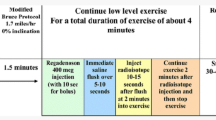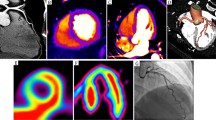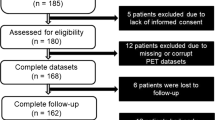Abstract
Background
Treadmill exercise nitrogen-13 (13N)-ammonia positron emission tomography (PET) has logistical challenges and limited literature. We aimed to assess its feasibility, image quality, and diagnostic accuracy in obese and nonobese patients.
Methods and Results
Between 2009 and 2012, 10,804 patients were referred for myocardial perfusion imaging, including 300 for treadmill PET, of whom 265 were included in this study. Treadmill testing and PET were performed using standard procedures. Image quality, perfusion, and summed stress score (SSS) were assessed. Invasive coronary angiography was performed within 90 days of PET in 43 patients. Mean ± SD body mass index (BMI) was 35.7 ± 7.7 kg/m2 (range 19.5-63.5 kg/m2). Feasibility of treadmill 13N-ammonia PET was 100%. Exercise duration was less for obese patients than nonobese patients (P < .001). Image quality was rated good for 96.9% of obese and 100% of nonobese patients. For all patients, sensitivity was 86.4% and specificity was 74.4%. Diagnostic accuracy did not change significantly with increasing BMI. SSS remained significant in predicting angiographic coronary artery disease after adjustment for age, sex, and Duke treadmill score.
Conclusions
Treadmill 13N-ammonia PET is highly feasible, yields good image quality, and has moderately high diagnostic accuracy in a small subset of obese and nonobese patients who are deemed able to perform treadmill exercise.



Similar content being viewed by others
References
Bateman TM, Heller GV, McGhie AI, Friedman JD, Case JA, Bryngelson JR, et al. Diagnostic accuracy of rest/stress ECG-gated Rb-82 myocardial perfusion PET: Comparison with ECG-gated Tc-99m sestamibi SPECT. J Nucl Cardiol 2006;13:24-33.
Iskandrian AS, Chae SC, Heo J, Stanberry CD, Wasserleben V, Cave V. Independent and incremental prognostic value of exercise single-photon emission computed tomographic (SPECT) thallium imaging in coronary artery disease. J Am Coll Cardiol 1993;22:665-70.
Chow BJ, Ananthasubramaniam K, dekemp RA, Dalipaj MM, Beanlands RS, Ruddy TD. Comparison of treadmill exercise versus dipyridamole stress with myocardial perfusion imaging using rubidium-82 positron emission tomography. J Am Coll Cardiol 2005;45:1227-34.
Miller T. The exercise treadmill test: Estimating cardiovascular prognosis. Clevel Clin J Med 2008;75:424-30.
Chow BJ, Al Shammeri OM, Beanlands RS, Chen L, deKemp RA, DaSilva J, et al. Prognostic value of treadmill exercise and dobutamine stress positron emission tomography. Can J Cardiol 2009;25:e220-4.
Chow BJ, Beanlands RS, Lee A, DaSilva JN, deKemp RA, Alkahtani A, et al. Treadmill exercise produces larger perfusion defects than dipyridamole stress N-13 ammonia positron emission tomography. J Am Coll Cardiol 2006;47:411-6.
Krasikova RN, Fedorova OS, Korsakov MV, Landmeier Bennington B, Berridge MS. Improved [13N]ammonia yield from the proton irradiation of water using methane gas. Appl Radiat Isot 1999;51:395-401.
Kwok JMF, Christian TF, Miller TD, Hodge DO, Gibbons RJ. Incremental prognostic value of exercise single-photon emission computed tomographic (SPECT) thallium 201 imaging in patients with ST-T abnormalities on their resting electrocardiograms. Am Heart J 2005;149:145-51.
McCully RB, Roger VL, Mahoney DW, Burger KN, Click RL, Seward JB, et al. Outcome after abnormal exercise echocardiography for patients with good exercise capacity: Prognostic importance of the extent and severity of exercise-related left ventricular dysfunction. J Am Coll Cardiol 2002;39:1345-52.
Akutsu Y, Hara T, Watanabe T, Yamanaka H, Okazaki O, Kashida M, et al. Determination of regional myocardial blood flow with 13N-ammonia positron emission tomography during low-grade exercise for evaluating coronary artery stenosis. Jpn Circ J 1994;58:303-14.
Akutsu Y, Harumi K, Michihata T, Watanabe T, Yamanaka H, Okazaki O, et al. Correlations between resting regional wall motion and regional myocardial blood flow (at rest and during exercise) in infarct-related myocardium—a study with [13N]ammonia positron emission tomography. Jpn Circ J 1997;61:665-72.
Krivokapich J, Smith GT, Huang SC, Hoffman EJ, Ratib O, Phelps ME, et al. 13N ammonia myocardial imaging at rest and with exercise in normal volunteers. Quantification of absolute myocardial perfusion with dynamic positron emission tomography. Circulation 1989;80:1328-37.
Tamaki N, Yonekura Y, Senda M, Kureshi SA, Saji H, Kodama S, et al. Myocardial positron computed tomography with 13N-ammonia at rest and during exercise. Eur J Nucl Med 1985;11:246-51.
Yonekura Y, Tamaki N, Senda M, Nohara R, Kambara H, Konishi Y, et al. Detection of coronary artery disease with 13N-ammonia and high-resolution positron-emission computed tomography. Am Heart J 1987;113:645-54.
Levine MG, Ahlberg AW, Mann A, White MP, McGill CC, Mendes de Leon C, et al. Comparison of exercise, dipyridamole, adenosine, and dobutamine stress with the use of Tc-99m tetrofosmin tomographic imaging. J Nucl Cardiol 1999;6:389-96.
Verna E, Ceriani L, Provasoli S, Scotti S, Ghiringhelli S. Larger perfusion defects with exercise compared with dipyridamole SPECT (exercise-dipyridamole mismatch) may reflect differences in epicardial and microvascular coronary dysfunction: When the stressor matters. J Nucl Cardiol 2007;14:818-26.
Schindler TH, Schelbert HH. “Mismatch” in regional myocardial perfusion defects during exercise and pharmacologic vasodilation: A noninvasive marker of epicardial vasomotor dysfunction? J Nucl Cardiol 2007;14:769-74.
Duvall WL, Croft LB, Corriel JS, Einstein AJ, Fisher JE, Haynes PS, et al. SPECT myocardial perfusion imaging in morbidly obese patients: Image quality, hemodynamic response to pharmacologic stress, and diagnostic and prognostic value. J Nucl Cardiol 2006;13:202-9.
Fiechter M, Gebhard C, Fuchs TA, Ghadri JR, Stehli J, Kazakauskaite E, et al. Cadmium-zinc-telluride myocardial perfusion imaging in obese patients. J Nucl Med 2012;53:1401-6.
Berman DS, Kang X, Nishina H, Slomka PJ, Shaw LJ, Hayes SW, et al. Diagnostic accuracy of gated Tc-99m sestamibi stress myocardial perfusion SPECT with combined supine and prone acquisitions to detect coronary artery disease in obese and nonobese patients. J Nucl Cardiol 2006;13:191-201.
Gimelli A, Bottai M, Giorgetti A, Genovesi D, Filidei E, Marzullo P. Evaluation of ischaemia in obese patients: Feasibility and accuracy of a low-dose protocol with a cadmium-zinc telluride camera. Eur J Nucl Med Mol Imaging 2012;39:1254-61.
Grossman GB, Garcia EV, Bateman TM, Heller GV, Johnson LL, Folks RD, et al. Quantitative Tc-99m sestamibi attenuation-corrected SPECT: Development and multicenter trial validation of myocardial perfusion stress gender-independent normal database in an obese population. J Nucl Cardiol 2004;11:263-72.
Thompson RC, Heller GV, Johnson LL, Case JA, Cullom SJ, Garcia EV, et al. Value of attenuation correction on ECG-gated SPECT myocardial perfusion imaging related to body mass index. J Nucl Cardiol 2005;12:195-202.
Hansen CL, Woodhouse S, Kramer M. Effect of patient obesity on the accuracy of thallium-201 myocardial perfusion imaging. Am J Cardiol 2000;85:749-52.
Miller TD, Hodge DO, Christian TF, Milavetz JJ, Bailey KR, Gibbons RJ. Effects of adjustment for referral bias on the sensitivity and specificity of single photon emission computed tomography for the diagnosis of coronary artery disease. Am J Med 2002;112:290-7.
Acknowledgments
We thank the Clinical Translational Sciences Activities Center at Mayo Clinic for statistical support of this project. This publication was supported by grant number UL1 TR000135 from the National Center for Advancing Translational Sciences. Its content is solely the responsibility of the authors and does not necessarily represent the official views of the National Institutes of Health. We also thank the nurses, nuclear technologists, and members of the cyclotron facility at Mayo Clinic who contributed immensely to the success of this project. Dr Drozdova’s work on the project was supported by European Regional Development Fund—Project FNUSA-ICRC (No. CZ.1.05/1.1.00/02.0123) International Clinical Research Center of St. Anne’s University Hospital in Brno).
Disclosures
Dr Chareonthaitawee receives a research grant from Astellas Pharma Inc. The other authors have nothing to disclose.
Author information
Authors and Affiliations
Corresponding author
Additional information
See related editorial, doi:10.1007/s12350-015-0099-2.
Rights and permissions
About this article
Cite this article
Aggarwal, N.R., Drozdova, A., Wells Askew, J. et al. Feasibility and diagnostic accuracy of exercise treadmill nitrogen-13 ammonia PET myocardial perfusion imaging of obese patients. J. Nucl. Cardiol. 22, 1273–1280 (2015). https://doi.org/10.1007/s12350-015-0073-z
Received:
Accepted:
Published:
Issue Date:
DOI: https://doi.org/10.1007/s12350-015-0073-z




